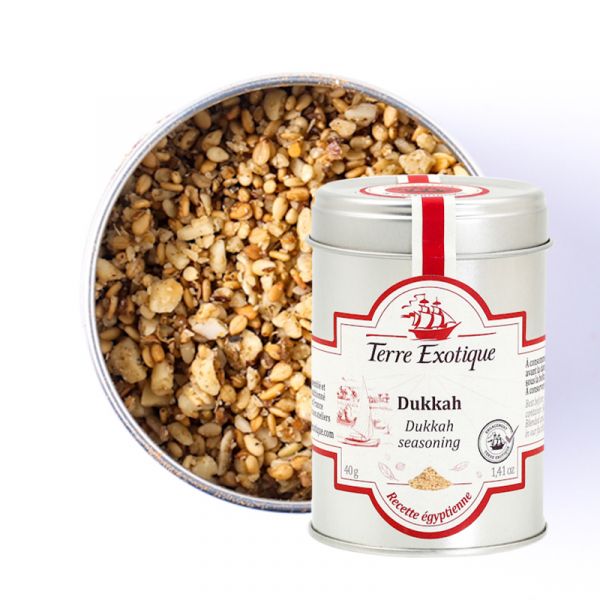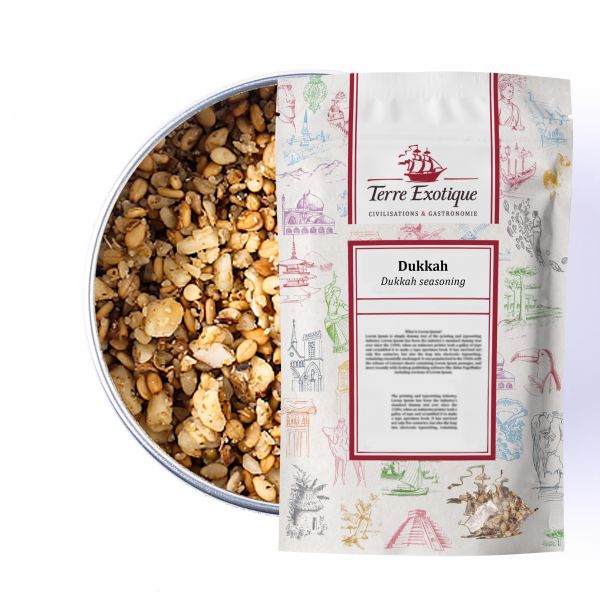



How to use Dukkah in your cuisine?
Dukkah is very useful in the kitchen for its crunchy texture and delicious flavors that will delight your taste buds and those of your guests.
Ideas for using Dukkah in your cuisine
In Cairo, the tradition is to dip bread successively in olive oil and then in Dukkah for a successful appetizer! However, that's not the only way to use it. Indeed, it proves to be a valuable everyday ally as it easily pairs with and instantly enhances the flavors of your dishes. Dukkah can be used as a breading for all your meats and fish. It goes wonderfully well with vegetables and adds a crunchy touch to composed salads.
Dukkah will enhance your sauces, marinades, and dressings instantly and pairs perfectly with fresh goat cheese. Dukkah can also be sprinkled on rice or potatoes to add a touch of originality.
Here are our recipe ideas for using the Egyptian spice blend Dukkah:
- Zucchini chips with Dukkah: Dip your zucchini slices to coat them with Dukkah, then fry them in a deep fryer;
- Fresh cheese with Dukkah: Roll the cheese balls in Dukkah to completely coat them. Chill for 20 minutes and serve;
- Vegetable salad with Dukkah: Sprinkle your salad with Dukkah, then serve;
- Breaded escalopes with Dukkah: Once the escalopes are dipped in beaten eggs, roll them in Dukkah and then cook them;
- Banana and Dukkah crumble: Mix 100g of Dukkah with sugar and butter, then cover the banana pieces with the mixture and bake.
Dukkah, the blend that will make you fall in love
Its notes of toasted spices and hazelnuts go wonderfully well with a sweet wine, cheese toast, or fresh pasta. Dukkah combines crunchiness, sweetness, and subtle flavor. Its sweet and savory notes bring a touch of originality.
What spices are in Dukkah?
Dukkah (pronounced "douka") is a blend of spices that originates from Egypt. It is composed of hazelnuts, sesame seeds, coriander, cumin, and roasted spices.
What are the origins of the Dukkah nut and spice blend?
Tracing the origins of Dukkah
The Dukkah spice blend originates from Egypt, but its exact date of appearance is not determined. It has been consumed primarily in the Middle East for several centuries. Additionally, the Dukkah blend is also very popular in Australia, New Zealand, and South Africa. The term Dukkah comes from an Egyptian Arabic word that literally means "to crush," referring to its production process. Indeed, the ingredients composing the blend are coarsely crushed.
The research of Edward William Lane, known for his research work on Egypt and its culture, has allowed the Western public to learn more about Egyptian society and culture. In one of his works, published in 1836, Edward William Lane explains that Dukkah was mainly used by the common people to season their bread and dishes. This spice blend is rich in nutrients, providing the necessary nutrients to meet the physical needs of the less fortunate.
Focus on Egyptian cuisine
Egyptian cuisine is relatively unknown, yet it is full of culinary wonders. It is significantly influenced by Arab cuisine but also Greek, Turkish, and Syrian cuisine. In fact, hummus, meatballs, and the famous mint tea are integral parts of Egyptian cuisine. Discover Egyptian cuisine through Dukkah and awaken your taste buds to new horizons!
| Allergen | Sésame, noisette, amande / Sesame, hazelnut, almond |
|---|---|
| Native country | FRANCE |
| Ingredients | SESAME, HAZELNUT, ALMOND, coriander, cumin, black pepper, salt. |
| Nutritional Info | VN Energie pour 100 g (energy for 100g) : 2589 kJ / 619 kcal VN Matière grasse (fat) : 53.2 g Dont acide gras saturés (of which saturated fat) : 5.9 g VN Glucides (carbohydrate) : 10.7 g Dont sucres (of which sugars) : 3.3 g VN Protéines (protein) : 21.3 g Vn Sel (salt) : 0.5 g |
| TRACES EVENTUELLES D'ALLERGÈNES | céleri, sésame, moutarde, fruits à coques. |
 Français
Français 

